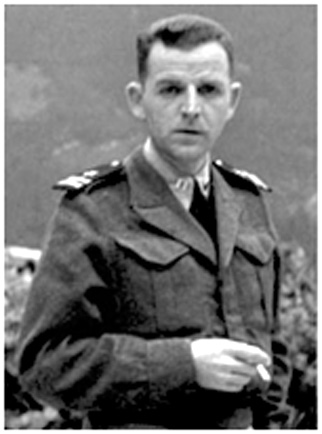The release this month of the motion picture The Monuments Men brings to mind the role that an Irvingtonian played as an officer in the unique World War II unit known as the Monuments, Fine Arts and Archives Section (MFAA).
Thomas Carr Howe, Jr., the son of former Butler University president Thomas Carr Howe, was born in Kokomo, Indiana on July 23, 1904. He was raised in Irvington, a suburb of Indianapolis, receiving his education in the neighborhood public school. Following his graduation from Shortridge Public High School in 1922, Howe continued his studies at Harvard University where he received his bachelor’s and master’s degrees in art history. In 1931 Howe became the assistant director of the California Palace of the Legion of Honor, one of San Francisco’s fine art museums, and in 1939 he was named its director. Howe served as art commissioner and organized an exhibition of the Mexican muralists for the Golden Gate International Exposition (1939-40) in San Francisco.
During World War II, Howe served two years in the United States Navy as a lieutenant before he was recommended by a Presidential commission to be a member of a group of officers assigned to the Allied armies in the “protection and salvaging of artistic monuments in war areas.” Transferring to the MFAA, Lt. Howe arrived in Paris in May 1945, three days after VE-Day, and was briefed before going to Germany on the work of the infamous Einsatzstab Reichsleiter Rosenberg — E. R. R. (The Rosenberg Task Force), a Nazi organization under the direction of Alfred Rosenberg that coordinated the looting in occupied countries of paintings, sculpture, tapestries, furniture, porcelain, enamels, jewels, gold, and silver from public and private owners.
Working out of Frankfurt and Munich, Howe and his team searched castles and salt mines for the hidden treasures of Western civilization. Near Berchtesgarden at the Rest House at Unterstein, the team retrieved the Hermann Göring Collection of 1,100 masterpieces, and in over 30 trucks the Reichsmarschall’s loot was transferred to the Central Collecting Point in Munich for safekeeping until its ownership could be determined. At the “fairy-tale” Castle of Neuschwanstein, the loot from Paris, including the exquisite Rothschild decorative pieces of jade, agate, onyx, jasper, and innumerable Oriental and European porcelains, was recovered. Howe’s team also probed the unlighted chambers of the Austrian salt mine at Alt Aussee where the rays of their flashlights caught the graceful marble statue of Michelangelo’s Madonna looted from Bruges, Belgium and more than 6,000 other treasures. Among the recovered masterpieces from this mine included the magnificent Ghent altarpiece by Hubert and Jan van Eyck — The Adoration of the Mystic Lamb — which was returned to Belgium with great ceremony, the first national treasure to be repatriated. Other masterpieces were retrieved from the Sudetenland monastery of Hohenfurth (present day Vyšší Brod, Czech Republic). “Really important things” — furniture and sculpture — were crammed into rooms and corridors of the monastery, the looted treasures from the Rothschilds of Vienna and the Mannheimers of Amsterdam.
Before returning to the United States in February 1946 and resuming his work in San Francisco, Howe served as deputy chief of the Monuments, Fine Arts and Archives Section at the United States Forces European Theater Headquarters (USFET) in Frankfurt. He returned to Germany in 1951 to direct the closing of the Central Collecting Point. Howe was honored by the Dutch government, and the French government made him a knight of the French Legion of Honor. Thomas Carr Howe, Jr. wrote an account of his experience in his book Monuments Man in Salt Mines and Castles: The Discovery and Restitution of Looted European Art (1946). After his retirement in 1968 from the Legion of Honor museum, Howe continued living in the San Francisco area until his death on July 12, 1994.
Other information about the 345 men and women who gave their expertise, and in at least two cases their lives, in the recovery of the treasures of the Western World stolen by the Nazis may be found at monumentsmenfoundation.org.




